By Chris Becker
Here’s my roundup of what happened this week in major macro markets. Remember, the following views are my own, do not constitute advice and are for information purposes only. I may have positions in any or all of the below and their associated markets both long and short, on an intra-day, daily and weekly basis for my own account. Please seek advice from a licensed adviser before making any investment decisions.
Currencies and Gold: The Currency Wars that aren’t currency wars continue….
The best way to measure or gauge currencies is through the US Dollar Index (DXY) which is made up of a basket of major currency pairs against the USD. For a while now it has been the major “risk on/risk off” indicator, with a lower USD usually meaning higher risk as US stock markets rise and push other risk assets higher, such as our own share market. But there has been a shift, as witnessed by the decline in the “undollar” currency, gold.
Starting with the weekly chart you can see that in comparison with QE2, where the DXY declined some 12%, QE3 has not been as “successful” as the USD slowly “loses” the currency wars, maintaining strength. The DXY has pipped above its 200 day moving average (the red line in all charts) as it continues to find strong support at the 79 level, as shown by the directionless ADX indicator below:
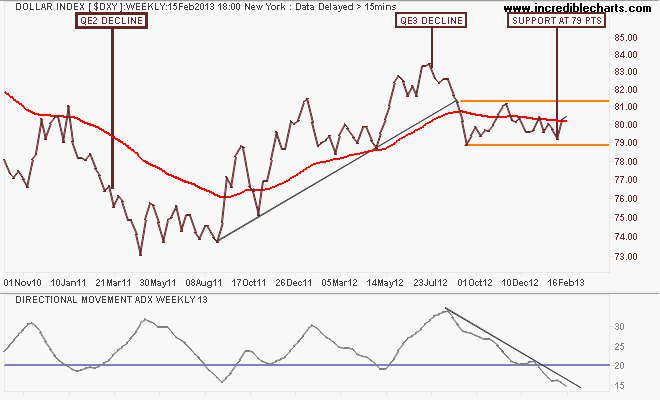
On the daily chart, this past week has seen the USD strengthen further (or more appropriately the other currencies weakening), bouncing off support, but not making any new highs in the medium term. There is potential here for a breakout above the upper orange line at around 80.5 points:
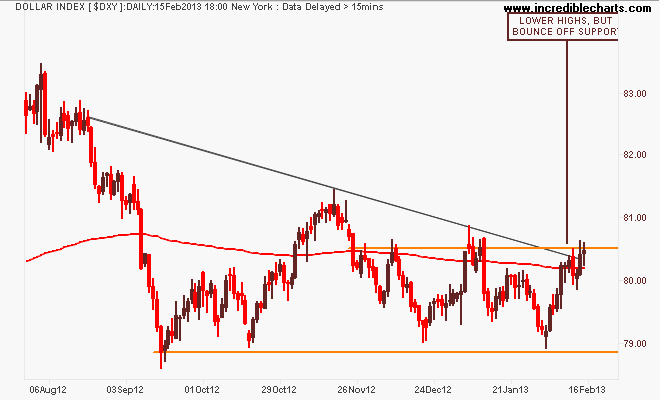
Because of its composition, the general opposite of the DXY is the euro (EUR/USD). After its break of the year plus down trend in August last year, the euro had broken out above resistance (former support) at the 1.31 level on the weekly chart. It has continued this trend, albeit after a hiccup during the US fiscal cliff saga, and with a reversal last week after becoming overbought, but still on trend:
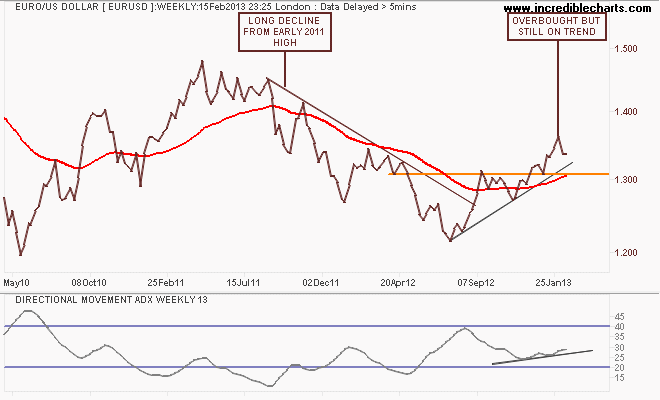
I pointed out on the daily chart previously that a pullback to support 1.32 was likely, which has continued this week. This is the key level to watch as it would break the uptrend from the July 2012 lows and possibly send the euro back to 1.28:
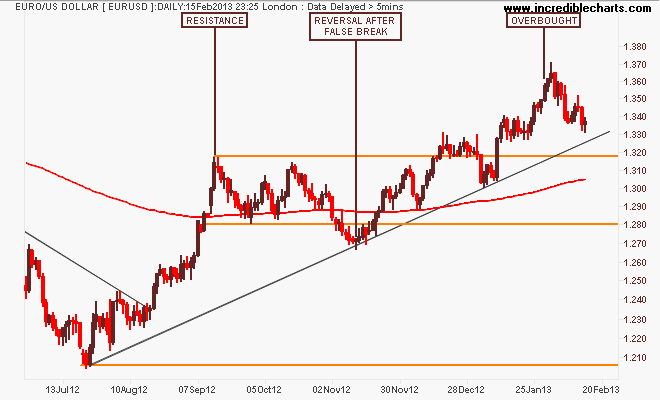
Time to look at the AUD again. The Aussie “battler” (AUDUSD) is slowly deflating as the series of lower highs in the weekly chart below shows, hitting resistance and sliding back to intermediate support around the 1.02 handle, and right on its trend line from the August 2010 lows:
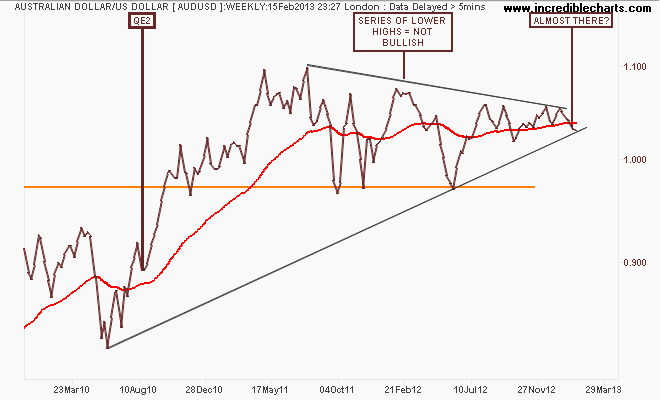
On the daily chart below you can see the sideways bullish condition has wavered, this week falling below the closely watched 200 day moving average and probably on its way to 1.02 against the USD. Have you done your online shopping for the year yet?
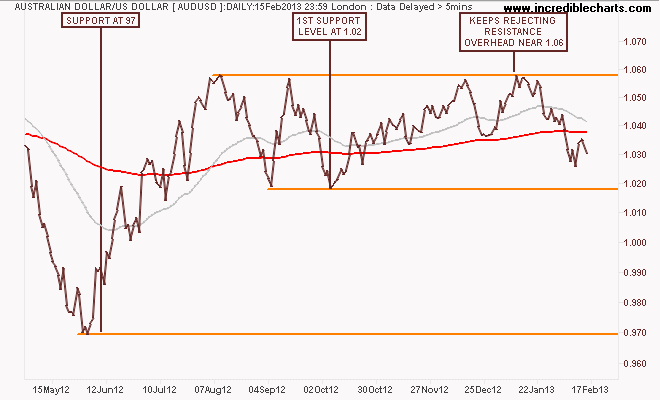
I’ll finish the currency section with the undollar currency, gold (USD). The main precious metal (I also trade silver, palladium and platinum) continues to confound the gold bugs and bears alike.
The medium term frustration can be seen on the weekly chart, with a sideways move for nearly 18 months with resistance at $1800 and support at $1560 per ounce providing the boundaries. My contention previously that a slowly rising trend of higher lows could be bullish was wrong. There is too much pressure here, mainly from speculative positions being wound back:
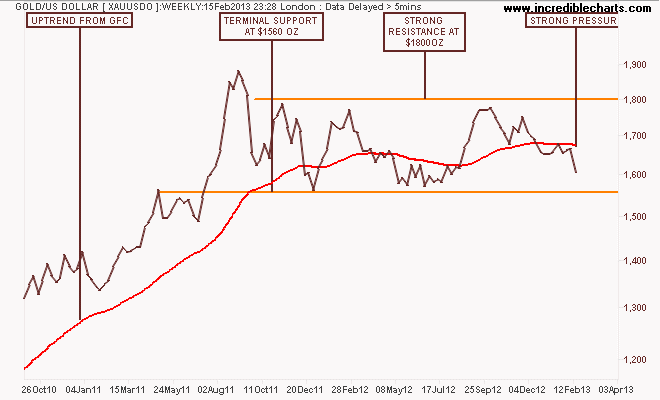
I did say “the short term position remains bearish (or not long) until a breakout above $1700”. Last night we had a big breakdown through support at $1630 and below $1600 per ounce. Short term, this is oversold (I remain short, but with a tighter stop), but it’s very hard to gauge if this is just a speculative unwinding and moving into stocks on the recovery meme, or something else….
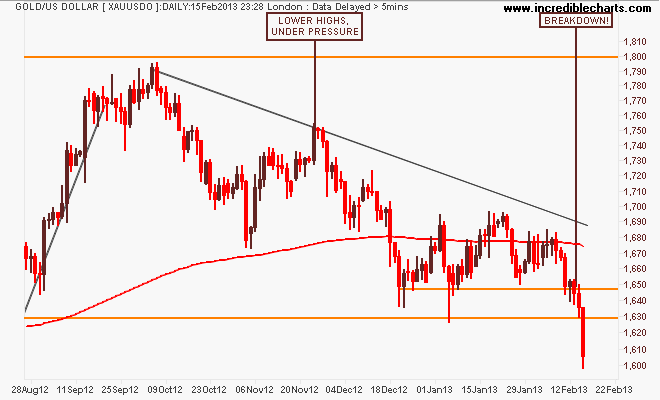
Commodities
For Australian investors particularly, there’s three major commodities to watch – crude oil, copper and iron ore. I’ll leave the last to Houses and Holes with his excellent daily updates (although it’s non tradeable for retail/private investors – Fortescue Metals (FMG) and Atlas Iron (AGO) are excellent proxies, both of which I trade regularly now), but crude oil is a great barometer displaying both demand and US dollar weakness.
There are two markers in crude, Brent and WTI. Here’s ICE Brent Crude, with the weekly chart of the spot price showing a small breakout above resistance at $117 per barrel:

Looks like that rounding bottom pattern established at support at $106 per barrel, has worked but not very strongly. Maybe because of the renewed strength in USD or lack of demand as shown by the falling 4Q GDP figures in Europe.
As I said previously, I remain long here on my weekly system, but I have my doubts about Brent because resistance above at $125 does not bode for high risk/reward trades. But this currency war could see a much larger move, particularly if those evil speculators (guilty) start bidding commodities up or, as we are seeing with gold, sell them off:
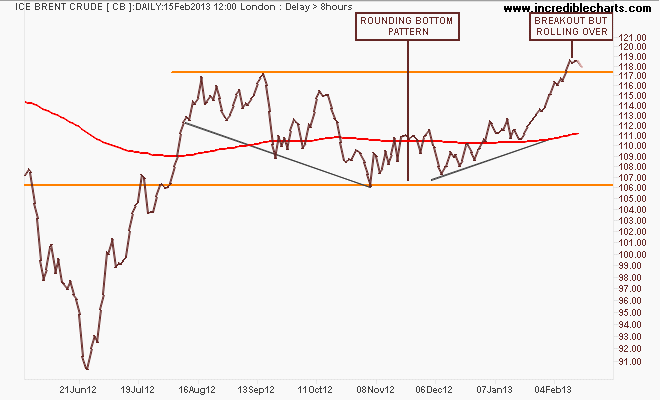
Copper is the other significant marker that is facing more resistance over head than Brent. Indeed WTI crude has a more similar pattern to copper than its heavier brother. Dr Copper is behaving weakly overall compared to the significant move during QE2, but a breakout above $8600 per tonne would surely give confirmation to a real bull market in risk:
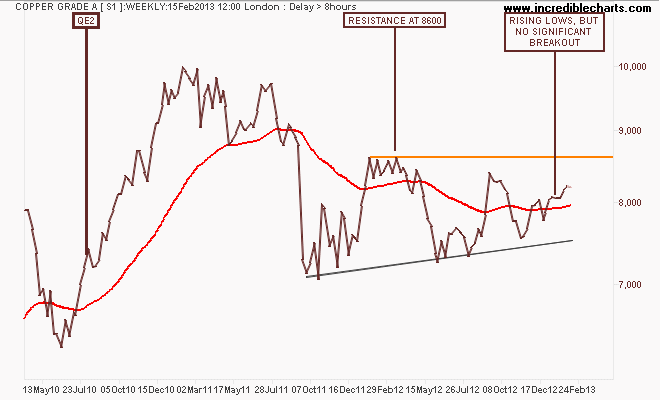
On a shorter time frame the metal remains in a small uptrend, where the reversal of the August breakout last year has been completed as it looks like the spot price has broken above the 8100 key level but hitting overhead resistance. This is definitely one barometer to watch as the current position confuses the view that a new “grand bull market” has started in growth assets:
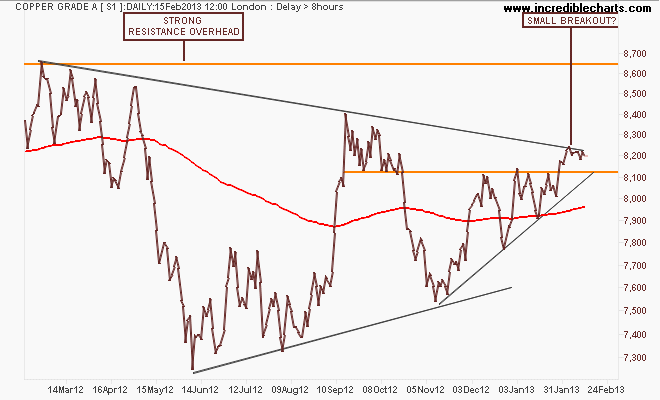
Risk and Volatility
Now to stocks, actually first the VIX, now almost at pre GFC levels, approaching the so-called danger zone: cheap, cheap, cheap.
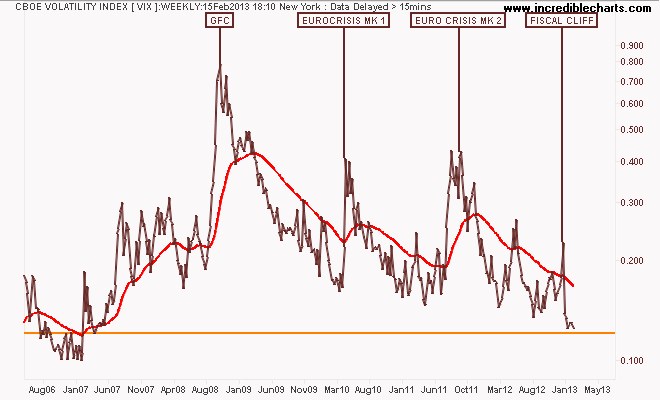
Here’s the daily chart (which I view each night/morning as part of my routine as it effects my position sizes and contingency plan). A break of support post the Xmas/NY fiscal cliff nonsense may be a contrarian signal to buy some very, very cheap VIX call options:
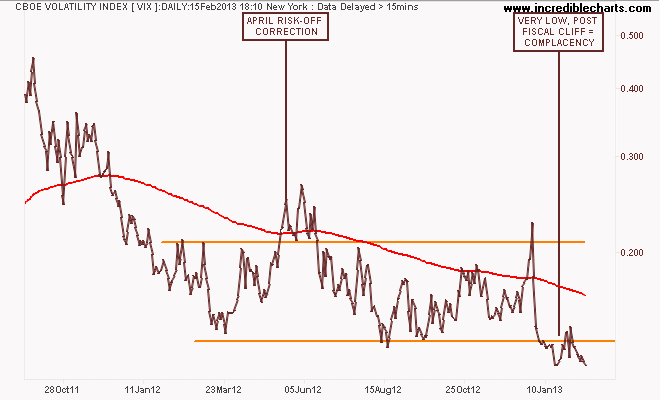
As for stocks, I’m just going to look at the US and local market, with Chinese markets closed this week and the Japanese markets overbought to buggery…
The US S&P500 index has the historic pre-GFC high at 1550 points in its sights, and has always been my target, but I’ve been surprised, and now concerned with the speedy move so far in the new year. I’m concerned that this represents a similar mood to the blowoff rally in 2007, with an increased likelihood of a pullback or correction to the lower trend line down to 1400 points or so. Here’s the monthly chart of the 13 year long secular bear market in US stocks:
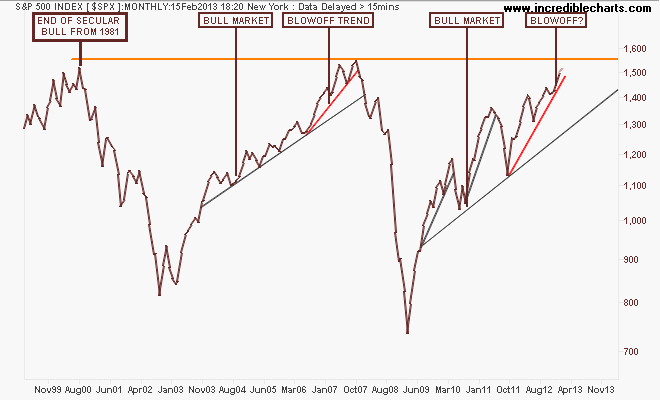
The weekly chart below shows how the series of higher highs is smaller on each up cycle which has two meanings. This is a true “buy the dip” cyclical bull market, with each fall exciting the minority bears (to their chagrin) and thus enticing the bulls who have the Fed on their majority side. The problem is it’s taking more effort but the new highs are not of the same magnitude. As I asked last week – and most non-permabulls ask each week when managing their book, instead of their ego – can this continue?
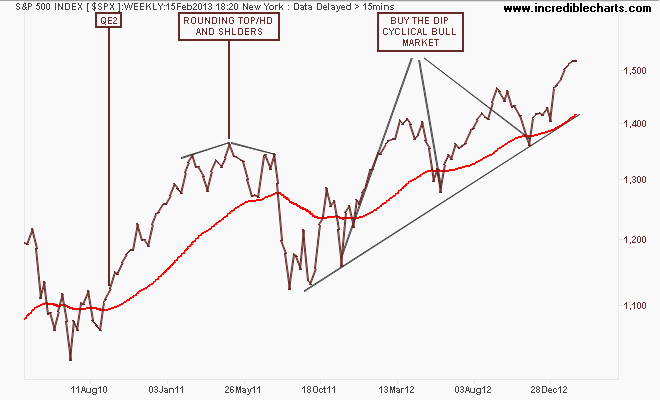
My main concern as an analyst is that this price movement – another Minsky stability/instability paradox – is precisely the type of last hurrah moves we see at the end of bull markets. But as I said last week, as a trader, it’s my job to be profitable and rely upon my positions, not opinions. And although my trading system remains long objectively, subjectively I think in the short term the market is slowly rolling over. Walmart’s announcement last night gave the bourse a bit of a rattle:
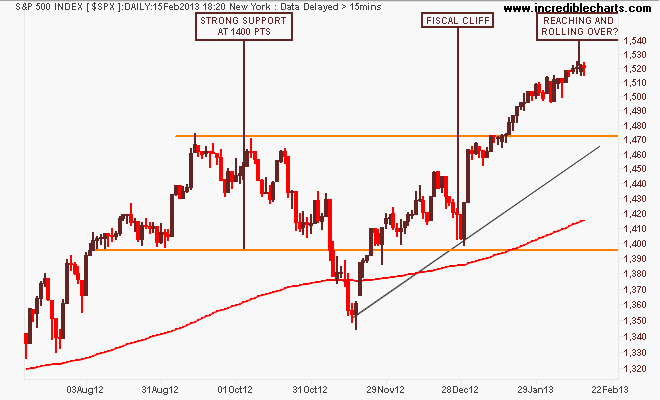
My stop remains at around 1480 points (resistance at the triple top in October last year), triggered on a fall below 1500 points, with a short entry trigger somewhere below that with a possible target to strong support at 1400 points. And then, buy the dip!
Whilst US markets have had 13 years in a secular bear market, the local S&P/ASX200 index is halfway through in my opinion. While it is now obviously in a cyclical bull market having closed the week at its highest post-GFC level above 5000 points, there are several things to note in the monthly chart below.
First, the key levels at 3800-4000 (strong support), 4400 (intermediate resistance and the outer edge of the index’s real value), 4900-5000 (strong resistance) and 6850 (the former high of the 2003-2007 bubble):
Second, check the 13 week ADX indicator below the chart. I’ve marked the periods where the indicator suggests oversold (OS) and overbought (OB) conditions through this cycle. We are now fast approaching a similar “reflation rally” overbought top that was created by the last big burst of monetary easing and profligacy by the RBA in early 2009:
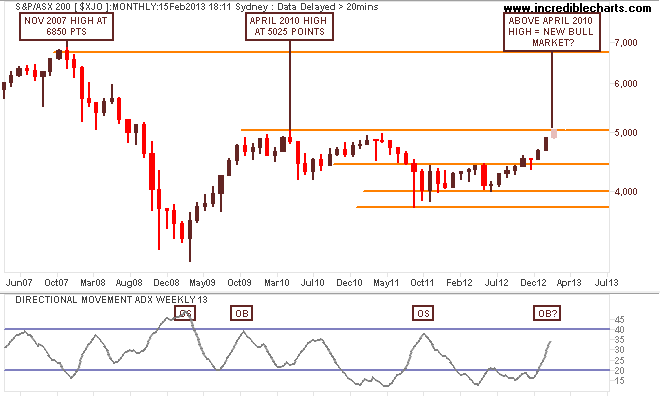
I posited last week that share markets are not a reflection of economic strength, as measured by GDP or unemployment or a host of other measures. In the post-GFC era it is clear that share markets are a reflection of monetary conditioning and with a weakening dollar and lower interest rates, our own market is finally being goosed as has happened in Europe and the United States (also look at New Zealand).
Here’s the chart from a Morgan Stanley study that shows how our current market is going right according to historical guidelines. We’ve had the rebound rally, the correction (2011), and now we are in a trading range. My opinion is we are likely to have a similar triple top pattern (a series of small corrections and counter rallies) throughout 2013 as this cycle has been far too quick:
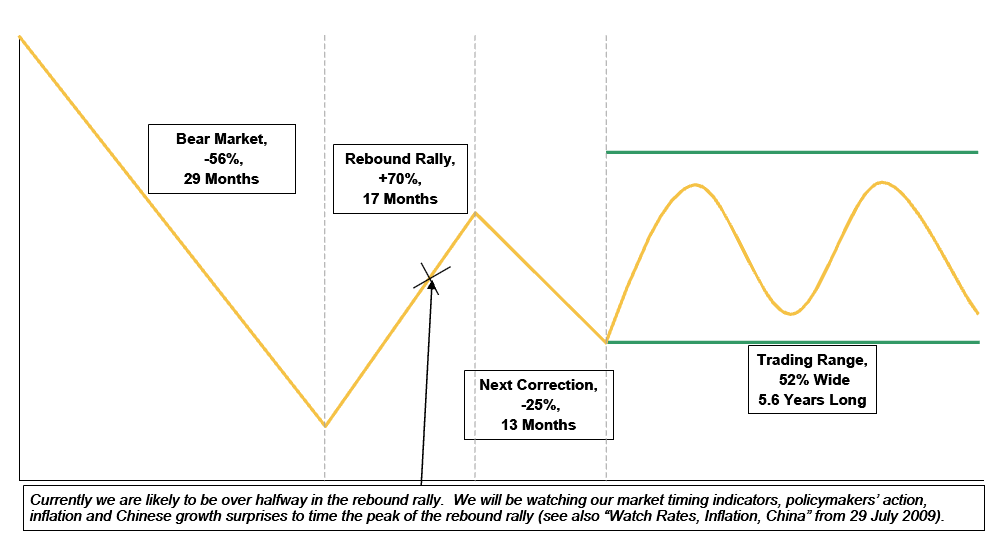
The weekly chart is the clear definition of overbought. You do not have 13 plus straight weeks in a row without a correction of some nature. This is no “permanently high plateau”:
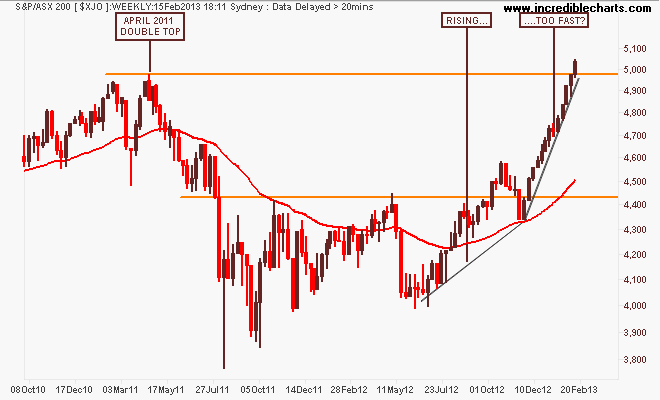
I previously suggested that a sizeable correction back to 4600 points would provide greater strength for a rally to break through 5000 points and further this year. Here is my technical target, based on a Fibonacci retracement of the GFC top and bottom. The 5000 point level is the 50% retracement, with the 61.8% giving an overhead target of 5400 points.
Its fairly obvious that to achieve this target (or even higher) requires a slightly more sedate trajectory, which means we will have a correction in the coming weeks and months:
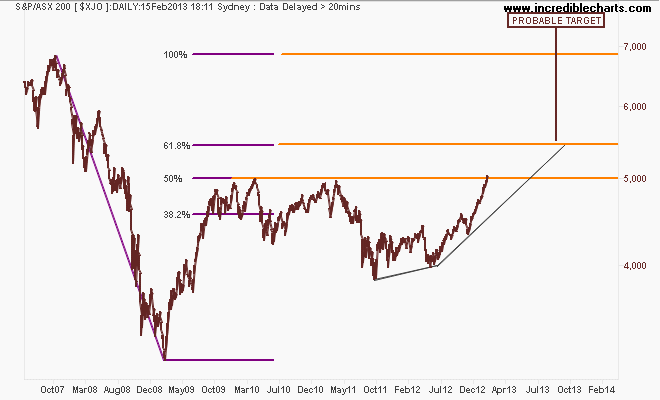
That’s all, remember to manage your risk first and the returns will come thereafter. See you next week and stay safe.
